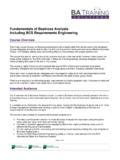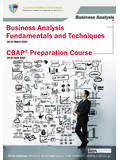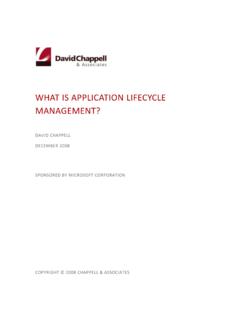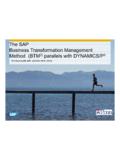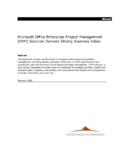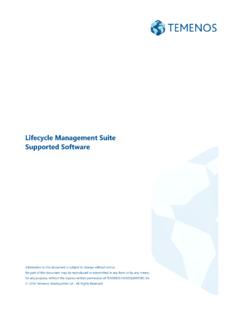Transcription of Business Analysis Lifecycle - Aotea Studios
1 Business Analysis Lifecycle by Sergey Korban Aotea Studios Ltd November 2011 Business Analysis Lifecycle Aotea Studios Ltd, 2011 2 Contents Introduction .. 3 Business Analysis Lifecycle .. 4 Practical Application .. 5 Start-Up Phase .. 5 Initiation Phase .. 5 Execution Phase .. 6 Closure Phase .. 7 Summary .. 7 Business Analysis Lifecycle Aotea Studios Ltd, 2011 3 Introduction Business Analysis as a discipline is maturing at a good pace. Many organizations operating in fast changing environments recognize the importance of the Business Analysis function and the benefits that it delivers to the Business .
2 The Business Analysis function helps lift up organizational performance, improve the bottom line and maintain competitive advantage. Looking back at the progress made, I see that the moment is right to introduce the Business Analysis Lifecycle . The IIBA developed good practice of Business Analysis and introduced it as the Business Analysis Body of Knowledge (BABOK)1. The BABOK describes knowledge areas, tasks, techniques and other relevant aspects of Business Analysis . It says that the primary purpose of the BABOK Guide is to define the profession of Business Analysis . The BABOK defines Business Analysis as the set of tasks and techniques used to work as a liaison among stakeholders in order to understand the structure, policies, and operations of an organization, and to recommend solutions that enable the organization to achieve its goals 2.
3 The BABOK introduces knowledge areas defined as knowledge required for effective Business Analysis , tasks to be performed within each knowledge area and generally recognized techniques helping execute the tasks . It also outlines relationships between different knowledge areas. However, the BABOK does not say that Business Analysis is a repeatable method. All my experience in Business Analysis illustrates that Business Analysis is not a one-off activity. In contrast, it is a repeatable method of specifying a Business need and an approach to finding a solution to satisfy the identified need. Lessons from each completed project feed into the improvement of Business Analysis activities for the coming projects.
4 In my opinion, the concept of the Business Analysis Lifecycle (BA Lifecycle ) can and should be applied to Business Analysis as it represents a structured and repeatable approach to solving a Business problem. Let s explore the Business Analysis Lifecycle . 1 The term BABOK is a registered trademark of IIBA . 2 BABOK , Business Analysis Lifecycle Aotea Studios Ltd, 2011 4 Business Analysis Lifecycle The diagram on the right illustrates the BA Lifecycle . It consists of seven areas: - Enterprise Analysis (EA) - Requirements Elicitation (RE) - Requirements Analysis (RA) - Solution Assessment & Validation (SA&V) - Planning & Monitoring (P&M) - Requirements Management & Communication (RM&C) - Iterative Improvements (II) The first six areas are well known.
5 They govern Business Analysis and help keep it on the right track within projects. In practice, Business Analysis is part of each project, however the lessons learned within each project phase or even iteration within a phase, are often not applied to improve Business Analysis and its key areas. To overcome this, I have added one more area which I call Iterative Improvements. Enterprise Analysis is the core of the BA Lifecycle as it deals with the current state of an organization and existing (limited) capabilities. EA closely interacts with Requirements Elicitation, Requirements Analysis and Solution Assessment and Validation where required.
6 The goal of these interactions is to specify the Business need, define the gaps and the required capabilities, and determine reusable components of the existing environment. These areas are supported by Planning and Monitoring and Requirements Management and Communication throughout the whole Business Analysis Lifecycle . As a Business analyst executes tasks within the indicated areas, s/he learns lessons and applies the obtained knowledge to improve execution of the tasks in the next iteration. This is the moment where Iterative Improvements comes into play. II completes the BA Lifecycle . The described Lifecycle works on improvement of Business Analysis all the time.
7 This concept delivers the following benefits: - Proven and effective approaches are used from the first project day - Planning of Business Analysis activities becomes more effective Business Analysis Lifecycle Aotea Studios Ltd, 2011 5 - Communication with stakeholders is effective and has fewer surprises - Requirements are not missed - Proven procedures, reports and templates are the norm - Business Analysis function continuously increases its value to the Business . Practical Application Let s see how the Business Analysis Lifecycle works in real situations. I m going to walk you through the phases of a successfully completed compliance project as an example of how a Business analyst can apply the BA Lifecycle .
8 Start-Up Phase3 The Business sent a memo to the Project Management Office about the need to satisfy new compliance requirements imposed on the company by a market regulation body. The PMO made a rough estimation (at a very high level) of the project scope and assigned a project manager to the project. The project manager engaged a BA to help refine project scope and determine how much the project may cost and how long it may take to complete. The project manager allocated the following tasks to the Business analyst: - Analyze the current state of the information landscape within the organizational unit that initiated the project - Determine project dependencies with ongoing projects - Specify high-level requirements based on the new market rules - Develop Project Vision and Solution Vision artifacts to support the development of a Business Case.
9 The Business analyst started work on the assigned tasks by having short and informal meetings with the key Business users. The objective was to get a clear picture of the newly required capabilities, the imposed market deadline, the length of the transition period and the financial impact non-compliance would have on the organization. These facts helped him define the project scope and outline possible changes to the current state. Initiation Phase The Business analyst used the collected information to develop the BA Plan, which included the approach to Business Analysis , Business Analysis deliverables, initial assumptions and 3 The names of phases are used in accordance with PRINCE2 Business Analysis Lifecycle Aotea Studios Ltd, 2011 6 constraints, effort estimations for the specified tasks, a list of key stakeholders and a communication matrix with preliminary details of communication patterns.
10 To complete the first task ( Analysis of the current state), the BA applied the techniques recommended in the EA knowledge area. At the same time, to speed up the task execution, the techniques from RE and RA were utilized. SA&V tasks and techniques were used to get the full picture of the current state. All the resulting information was presented in the Current State Analysis document. The document was used to refine the original project scope and the time estimates made earlier. The next step was to specify the high level requirements. Again, RE, RA and RM&C were at play and helped complete the Analysis at the enterprise level and do the groundwork for developing the Project Vision and Solution Vision artifacts.



